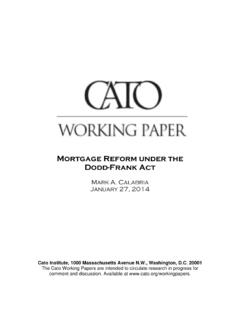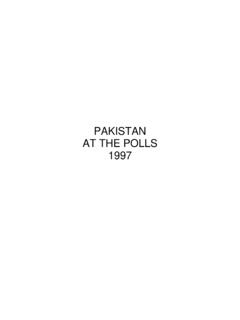Transcription of PAGE 8 PAGE 17 PAGE 6 - Cato Institute
1 Milton Friedman, perhaps the greatest champion of freedom ofthe past half century, passed away November 16 at the age of 94. In this issue we remember his long association with the CatoInstitute, from smuggling books into Poland in 1982 to the awardingof the third Milton Friedman Prize for Advancing Liberty in , Milton Friedman in his Cato 25 cap at the Cato Sponsors Pic-nic after the Cato Institute s 25th Anniversary Dinner in 2002, at whichthe first Friedman Prize was awarded. January/February 2007 Vol. XXIX No. 1 MORE ON PAGE 4 id libertarians swing the 2006election? Election and poll re-sults suggest it s possible. Whilepartisans still voted along partylines, Republicans lost big a-mong independents. By our analysis, lib-ertarians may be the largest bloc of suchindependent-minded swing voters. Par-ticularly in states with high concentra-tions of libertarians such as Arizona,Nevada, Colorado, Montana, and NewHampshire, disaffected libertarians like-ly cost Republicans House and Senateseats.
2 But an obsession with politicalpolarization and the red-blue divide hasprevented most pundits from seeing theimpact of libertarian-leaning since the impeachment of Pres-ident Clinton and the Florida ballotproblems in 2000, we ve been told thatwe re a polarized nation, sharply splitbetween red state Republicans and blue state Democrats. And the riseof blogs has intensified that sense, byallowing people to get their daily, evenhourly, dose of the liberal or conservativeparty BOAZ is executive vice president of the CatoInstitute. DAVID KIRBYis executive director of America sFuture Foundation. They are coauthors of The Liber-tarian Vote, a Cato Institute Policy D ON PAGE 14A WEEKIN THE LIFEWhat Catodoes all dayPAGE 6 ANDREIILLARIONOVWhat s gonewrong in thenew RussiaPAGE 17 CHUCKHAGELS enator deploresRepublicans loss of visionPAGE 8 LibertarianVoters in2004 and 2006BY DAVID BOAZ AND DAVID KIRBYD14 Cato Policy Report January/February 2007 But in fact millions of people don t fitthe liberal-conservative dichotomy.
3 Theymay be fiscally conservative and socially lib-eral (or tolerant), that is, broadly libertari-an. Or they may be liberal on economicissues and conservative on issues of per-sonal freedom, and we might call them sta-tist or populist. Either way, they don t fitneatly into the liberal or conservative box,and they often find themselves tornbetween conservative Republican and liber-al Democratic candidates for recent polls suggest that 10 to 20percent of Americans fall into the libertari-an quadrant. Indeed, libertarians are a big-ger share of the electorate than the much-discussed soccer moms or NASCAR dads, and they are increasingly a swingvote. Over the past six years Republicanshave expanded entitlements and spent tax-payers money faster than Democrats, giv-ing libertarians less reason to stick withtheir traditional voting patterns.
4 Pollsshow that in both 2004 and 2006 libertari-an voters shifted toward the Democrats,and they may well have cost Republicanscontrol of is this substantial and growing lib-ertarian strength not better recognized?Political scientists have taught for morethan 50 years that politics is arranged on aliberal-conservative continuum, so we re allused to that. And indeed, political activistsand elected officials do seem to havearranged themselves into those two camps,rather than a more accurate reflection ofthe total electorate. Because of the constantrepetition of the liberal-conservative spec-trum, most libertarian-minded votersdon t identify themselves as libertarians,and they aren t organized in libertariangroups. But it s time for pundits, pollsters,and politicians to pay more attention tothe libertarian TodayFor more than a dozen years now, theGallup Poll has been using two broad ques-tions to categorize re-spondents by ideologyabout economic andsocial freedom.
5 Gallupconsistently finds about20 percent of respon-dents to be 2006 they found21 percent libertarians,along with 21 percentliberals, 20 percent pop-ulists, and 25 percentconservatives (12 percentwere unclassifiable). Adding a third ques-tion from the Gallup survey to create amore robust definition, we found that 13percent of Gallup s 2006 respondentscould be classified as libertarians. Using similar questions from the PewResearch Center, we found 14 percent lib-ertarians. And from the generally acknowl-edged gold standard of public opiniondata, the surveys of the American NationalElection Studies, which has asked thesame questions for 15 years, we selectedthree questions about political those questions, we found that in2004 libertarians were 13 percent of thevoting-age population and 15 percent ofactual publishing that study, we com-missioned Zogby International to ask thesame ANES questions to 1,012 actual(reported) voters in the 2006 again, we found that 15 percent ofthem could be defined as libertarian onour three-question LibertariansSo how do libertarians vote?
6 That s thebottom line for candidates and find good evidence not only that liber-tarians exist, and that they vote, but thattheir votes are currently in flux. Libertariansmay be the next great swing the dominance of fiscal and eco-nomic issues over the past generation, it isperhaps not surprising that libertarianshave tended to vote Republican. UsingANES data, we find that libertarians havevoted heavily Republican in recent presi-dential elections, but with interesting variations. In 1988, given a choice betweenGeorge H. W. Bush s watered-downReaganism and Michael Dukakis s combi-nation of big-government orthodoxy and card-carrying membership in the ACLU, libertarians voted 74 to 26 percent forBush. In 2000 libertarians gave 72 percentof their votes to George W. Bush, who saidevery day on the campaign trail, My oppo-nent trusts government.
7 I trust you, andonly 20 percent to Al Gore, of whom Bush sclaim seemed entirely too accurate. But in 1992, after the senior Bush s taxincrease, libertarians split their previouslyRepublican majority almost evenly be-tween Bush and third-party candidate RossPerot. That suggests that the libertarianaffinity for Republicans is easily also gave a high percentage oftheir votes to third-party candidates in1980 (independent John B. Anderson andLibertarian Party candidate Ed Clark) and1996 (again Perot).But the striking fact in our data analysisis what happened in 2004. The libertarianvote for Bush dropped from 72 to 59 per-cent, while the libertarian vote for theDemocratic nominee almost doubled. It snot hard to imagine why. Bush s record onfederal spending, centralization of educa-tion, expansion of entitlements, the war inIraq, executive authority, the federal mar-riage amendment, and civil liberties wascertainly sufficient to dissuade many liber-tarian voters.
8 Sen. John F. Kerry offered Continued from page 1 Source: William S. Maddox and Stuart A. Lilie, Beyond Liberal and Conservative(Washington: Cato Institute , 1984), p. Ideologies: A Four-Way MatrixForAgainstFor AgainstGovernment Intervention in Economic AffairsExpansion of Personal Freedoms LiberalPopulistLibertarianConservativeJa nuary/February 2007 Cato Policy Report 15little for libertarians other than notBush. He voted for the war and thePatriot Act, never articulated a clear alter-native position on either, and offeredstandard Democratic support for highertaxes and spending. Nevertheless, he nar-rowed the Republican majority amonglibertarians from 52 points to 21 two more years of war, wiretap-ping, and welfare-state social spending, wefound similar patterns in 2006. In theZogby survey, 59 percent of libertariansvoted for Republican candidates forCongress, and 36 percent voted for Demo-crats.
9 Comparing those results to the lastoff-year election in 2002, we find a 24 per-centage point swing to the is, libertarians voted for Republicancongressional candidates by a margin of47 percentage points in 2002, and of only23 points in put this in perspective, front-pagestories since the election have reported thedramatic 7-point shift of white conserva-tive evangelicals away from the Repub-licans. The libertarian vote is about thesame size as the religious right vote meas-ured in exit polls, and it is subject toswings more than three times as the 2000 election Karl Rove wasconvinced that 4 million Christian evan-gelicals had stayed home, and he wasdetermined to get them to the polls in2004. By our calculations, Republicanscarried the libertarian vote by millionvotes in the off-year election of 2002 andby only million votes in 2006.
10 That s aswing of million libertarian , it takes two new base voters toreplace one swing voter who switchesfrom one party to the other. Rove and hiscolleagues should have been watching outfor the libertarian vote as who said the war in Iraqwas the most important issue voted 64-31for Democratic congressional who stuck with Republicancandidates were most likely to describeterrorism or security as the most impor-tant issue. Libertarians for whom federalspending was the most important issuewere most likely to vote for third-partycandidates: 39 percent Democratic, 38percent Republican, 22 percent other. It sa sad commentary on today s RepublicanParty when its candidates do so poorlyamong voters concerned about should be particularlytroubled about their standing with youngvoters, including young libertarian in the 18--34 age groups are morelikely than voters over 55 to be libertarian,and the younger libertarians voted by StateCongressional elections are held instates and districts.















